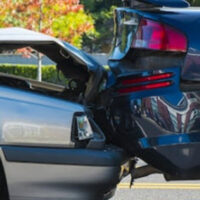Determining Fault in a Rear-End Accident

Car accidents happen in a variety of ways. Many people are rear-ended by other vehicles while on the road. When this happens, who is at fault?
The myth is that the driver who rear-ends the other vehicle is always at fault. While this is true in most cases, it’s safe to say that there are exceptions.
The driver in the rear is usually at fault because the rules of the road involve keeping a safe distance from other vehicles on the roadway. When a person rear-ends another vehicle, it is likely because they were not keeping a safe distance. They may have been tailgating and so when the vehicle in front stopped, the vehicle in the rear could not stop in time.
It’s a good idea for drivers to stay 2-3 vehicle lengths behind the vehicle in front. This is because there are situations in which a driver needs to stop suddenly. They may need to stop suddenly to avoid hazards, such as an animal, pedestrian or debris in the road. Sometimes traffic gets congested suddenly, so a car needs to stop quickly.
However, there are situations in which the vehicle in front may be held liable for a car accident. For example, if the vehicle reverses suddenly without warning and hits the vehicle behind them, then they could be held liable. This is also true if the vehicle has a flat tire or becomes disabled in the road and the driver does not turn on the car’s hazard lights. Also, non-functioning brake lights can cause a vehicle to rear-end another.
How is Fault Determined?
There is no clear-cut way to determine fault, as there are no set guidelines. Fault is determined by the insurance adjuster. They will look at the events and assess the damage involved. They will look at the information from all parties involved and talk to witnesses.
The insurance company will look at who was negligent. To prove negligence, there must be a duty, which all drivers have. There must be a breach of this duty, which means that the driver was not driving properly or following the rules of the road. It must also be proven that the driver’s breach of duty caused the crash. Also, there must be damages involved, such as property damage, injuries, medical bills, or pain and suffering.
A person does not have to be 100% at fault for a crash. Sometimes fault can be split if it is determined that both parties contributed to the accident.
Contact a Personal Injury Lawyer
Fault is not always clear in a car crash. Even if you were rear-ended, there are ways in which you could be held responsible.
The aftermath of a car crash can be complicated. Get the help you need from the Houston car accident lawyers at The West Law Office, PLLC. We can assess your case, determine liability and ensure you receive all the compensation you deserve. Schedule a consultation by calling 281-347-3247 or filling out the online form.
https://www.houstonpersonalinjury.law/involved-in-a-hit-and-run-accident-now-what/
